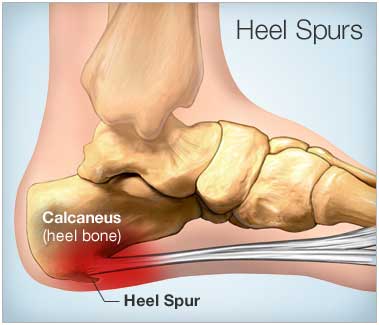
Calcaneal spur
 A calcaneal spur or heel spur is a small osteophyte (bone spur) located on the calcaneus (heel bone).
A calcaneal spur or heel spur is a small osteophyte (bone spur) located on the calcaneus (heel bone).
Cause -
1. When a foot bone is exposed to constant stress, calcium deposits build up on the bottom of the heel bone.
2. Obese people
3. Flatfooted people
4. Women who constantly wear high-heeled shoes
5. Repetitive stress injury
6. Strains on foot muscles and ligaments
7. Stretching of the plantar fascia
8. Repeated tearing of the membrane that covers the heel bone
9. Athletes whose activities include large amounts of running and jumping.
10. Decrease plantar fascia flexibility
11. Spending most of the day on one's feet
12. Poorly fitted or badly worn shoes, especially those lacking appropriate arch support
13. Diabetic patient are more susceptible to calcaneal spur.
Types -
1. Inferior calcaneal spur
2. Posterior calcaneal spur
Symptoms -
1. Pain in the region surrounding the spur, which typically increases in intensity after prolonged periods of rest.
2. Patients may not be able to bear weight on the afflicted heel comfortably
3. Running, walking, or lifting heavy weight may exacerbate the pain
4. Patient is unable to place his heel on the ground immediately after waking up in the morning
5. Slowly after taking a few steps, with difficulty, the pain gradually disappears.
6. As the day wears off, the pain recurs later in the evening or night.
7. Foot fatigue and discomfort is often reported.
8. Limp is another common complaint.
9. Calf muscle pain and cramps cold be seen in few cases
10. On pushing the foot down (called plantar flexion), there could be pain.
Diagnose -
1. X-ray
Aim of physiotherapy -
1. Reduce pain
2. Reduction of inflammation
3. Relieve stress on the plantar fascia
4. Mobilization of stiff joints
5. Strengthen the intrinsic muscles of the foot
Physiotherapy Treatment -
1. Ultrasound- improves cell metabolism and cell membrane permeability, thus enhancing tissue healing
2. Mobilization and manual therapy-significant effect to restore any restricted mobility between the foot bones and muscles
3. Foot Tapping and strapping-taping supports the foot ,placing stressed muscle and ligaments in a restful state
4. Stretching Exercises- stretches the tight muscles and fascia
5. Strengthening Exercises- leg and ankle strengthening exercises
6. Use insoles and orthotics

